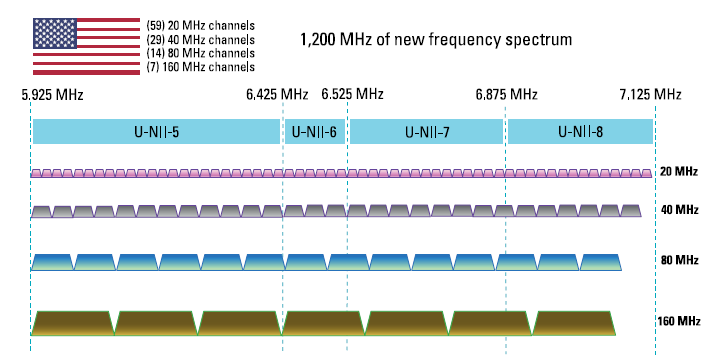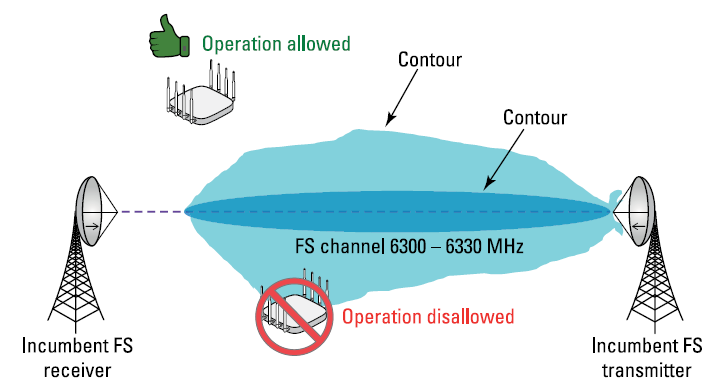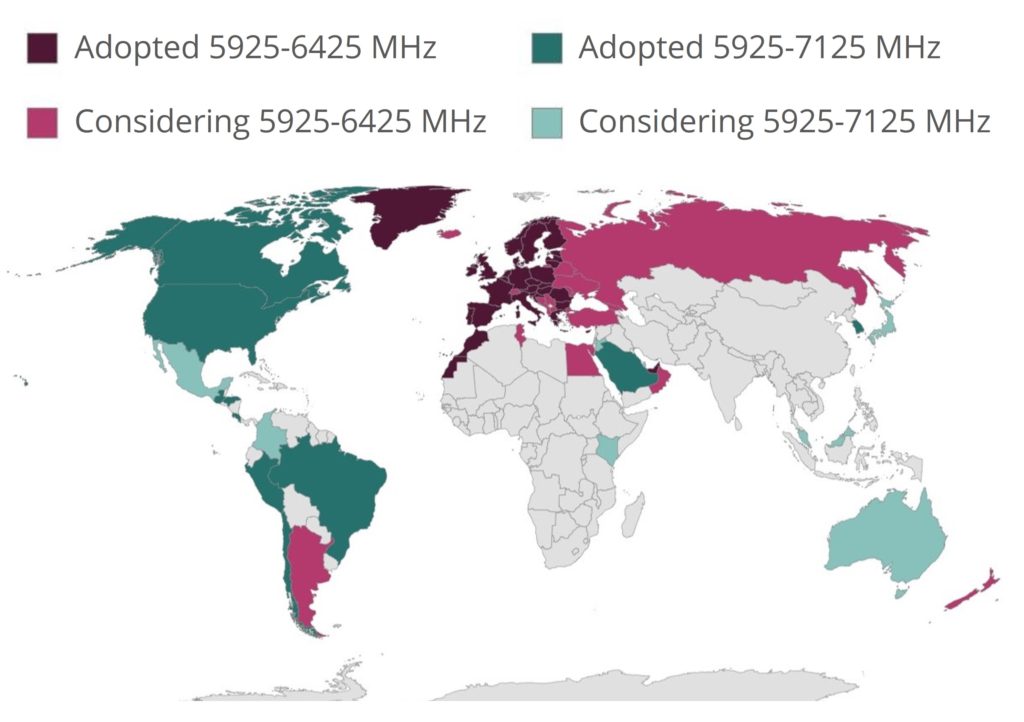We discussed in the last article Wi-Fi Generations definition, Timeline, and Benefits the journey and benefits of Wi-Fi technology in general and Wi-Fi Timeline from 802.11a to 802.11ax. In this article, we will talk more about Wi-Fi 6E, its definition, and its benefits.
Even as Wi-Fi 6 deployments continue to ramp up, the industry is preparing for the biggest Wi-Fi upgrade to date—Wi-Fi 6E.
What is Wi-Fi 6E?
On April 23, 2020, the US Federal Communications Commission (FCC) voted unanimously to allocate 1,200 megahertz (MHz) of spectrum for unlicensed use in the 5.925-7.125 GHz (6 GHz) band. At the same time, the Wi-Fi Alliance decided to extend the Wi-Fi 6 standard (802.11ax) to include the new 6 GHz band. The result is Wi-Fi 6 extended or Wi-Fi 6E.

6 GHz U-NII bands and Wi-Fi channels (United States)
Wi-Fi 6E, an extension of the current Wi-Fi 6, helps alleviate network constraints and provides room for growth by more than doubling the available spectrum with wider channels for lower latency.
Benefits of Wi-Fi 6E
Wi-Fi 6E devices operating in the 6 GHz band will be immediately able to take advantage of the benefits provided by this greenfield spectrum.
- High Capacity – With 59 new 20 MHz channels available in the 6 GHz band, congestion issues will be immediately relieved. Wi-Fi 6E access points will not need to compete for spectrum and will be able to operate on congestion-free channels.
- Higher Speed – 1200 MHz of contiguous spectrum enables 7 new 160 MHz channels and 14 new 80 MHz channels. Network administrators will be able to enable widespread use of wider channels without the risk of interference from overlapping channels and sufficient spatial reuse. Wider channels deployments will unlock multi-Gigabit Wi-Fi speeds for end-users.
- Less Congestion: Current Wi-Fi offers 27 non-overlapping 20 MHz channels, while Wi-Fi 6E will offer 59 new 20 MHz channels. The added channels will alleviate many of the congestion challenges and enable better support for more connected devices and device types.
- Low Latency – IEEE’s decision to reserve access of the 6 GHz band to 802.11ax devices will reduce the latency and enable < 1 ms latency for 6E devices. First by removing all legacy slower devices and also by allowing only 802.11ax (OFDMA, MU-MIMO, 1024 QAM) capable devices, that can take full advantage of the capacity and latency improvement features provided by this technology.
Key differences between Wi-Fi 5, Wi-Fi 6, and Wi-Fi 6E
Wi-Fi 6E will enable delivery of the deterministic, low-latency, highly reliable quality of service (QoS) required for next-generation wireless applications.
One key difference of using the 6 GHz frequency band for 802.11ax technology is there is no need for backward compatibility. Because 802.11a/b/g/n/ac radios operate only on the 2.4 GHz or 5 GHz band, and not the 6 GHz band, protection mechanisms aren’t needed.
The 6 GHz frequency band will be a “pure” 802.11ax technology band for Wi-Fi communication.

Key differences between Wi-Fi 5, Wi-Fi 6, and Wi-Fi 6E
Compared to Wi-Fi 6, Wi-Fi 6E is not a new technology. The difference is that it operates in the 6 GHz band instead of 2.4/5 GHz for Wi-Fi 6, and has more bandwidth—1.2 GHz vs 600 MHz. This makes Wi-Fi 6E functionally different in a few key ways:
- Wi-Fi 6E mandates OFDMA which enables a more stable device-to-network connection.
- Because Wi-Fi 6E has the 6 GHz band to itself, no legacy devices, it can support much faster speed and lower latency.
- Due to its higher frequency spectrum, Wi-Fi 6E has less range than Wi-Fi 6.
What are the rules governing 6E?
- AP Decides: Unlike current Wi-Fi, in which end-user devices make uncoordinated roaming decisions that can lead to poor connectivity, devices operating in the 6 GHz band must obey the operating rules of the AP which has better visibility to make these decisions.
- Coordination Requirements: The biggest change within Wi-Fi 6E is the new requirement to enforce frequency coordination among standard power APs via Automated Frequency Coordination
(AFC). Wi-Fi AFC provides a list of frequencies where the AP can operate safely without interfering with other incumbents like fixed microwave operators.

Automated Frequency Coordination
- Uncoordinated Operations: While low-power indoor APs may operate within the 6 GHz band without AFC control, they are restricted from having weather-resistant enclosures, external antennas, and battery-only operation. Such restrictions prevent equipment manufacturers from creating U-NII 6 and U-NII 8 band-supported APs, causing potential interference problems for existing microwave wireless operators.
- 11ax required: Only 802.11ax devices will be able to operate within the 6 GHz band. With no need to support legacy devices, Wi-Fi 6E can operate at its intended maximum efficiency, while legacy devices can use 2.4 GHz and 5 GHz as normal.
6 GHz Worldwide
As shown in the below figure, many world regions are making all or portions of the 6 GHz frequency band available for Wi-Fi. Also, you can see all the updates on this page

Countries Enabling Wi-Fi 6E
References
- Wi-Fi Alliance, https://www.wi-fi.org/
- Wi-Fi Alliance, Wi-Fi 6E, and 6 GHz Update.
- Qualcomm, Industry Readies for Wi-Fi 6E
- Aruba, Six strategies to get the most out of Wi-Fi 6E and 6 GHz white paper.
- LitePoint, A Guide to Wi-Fi 6E white paper.
- Commscope, What is Wi-Fi 6E technology brief.


